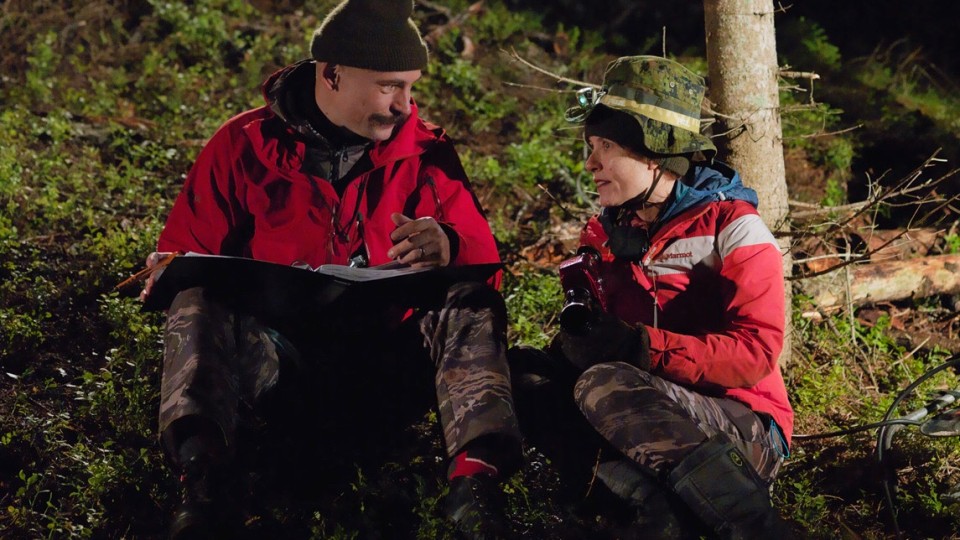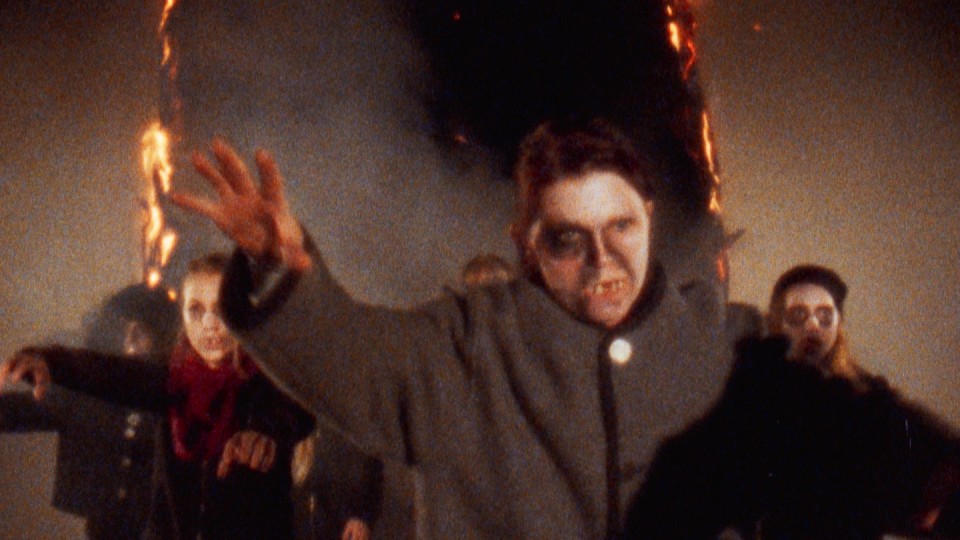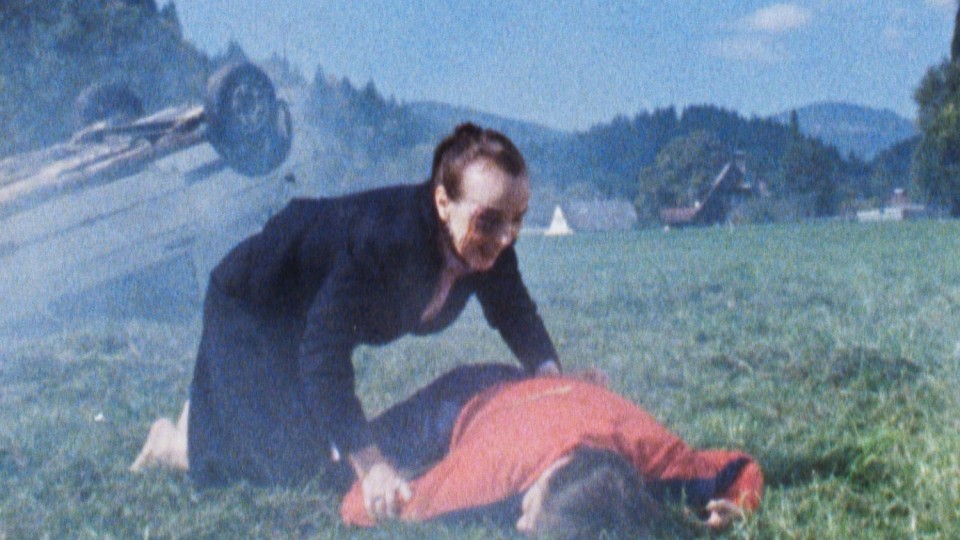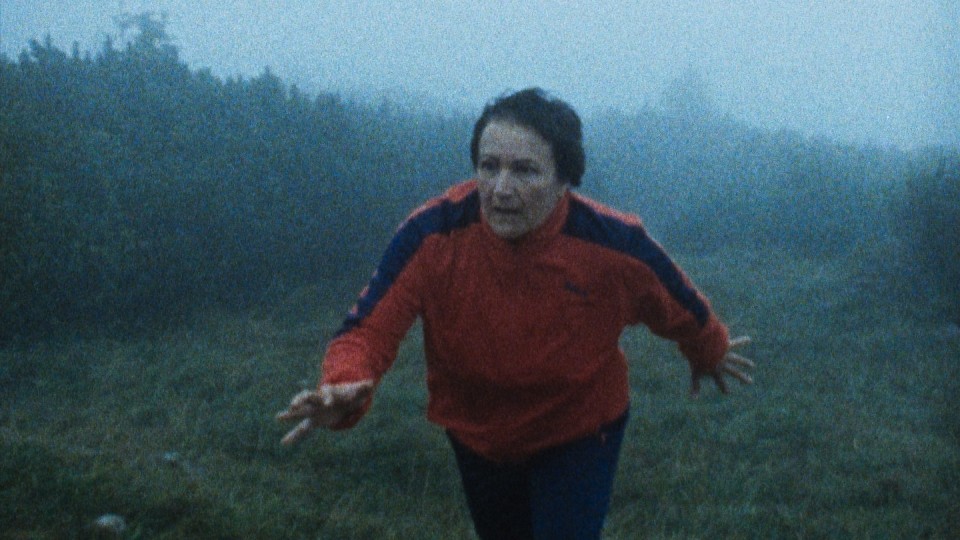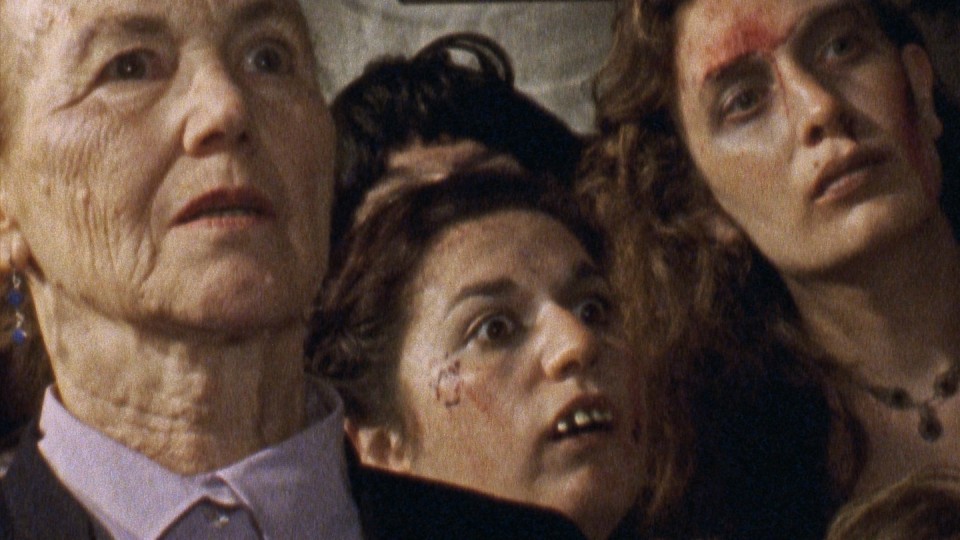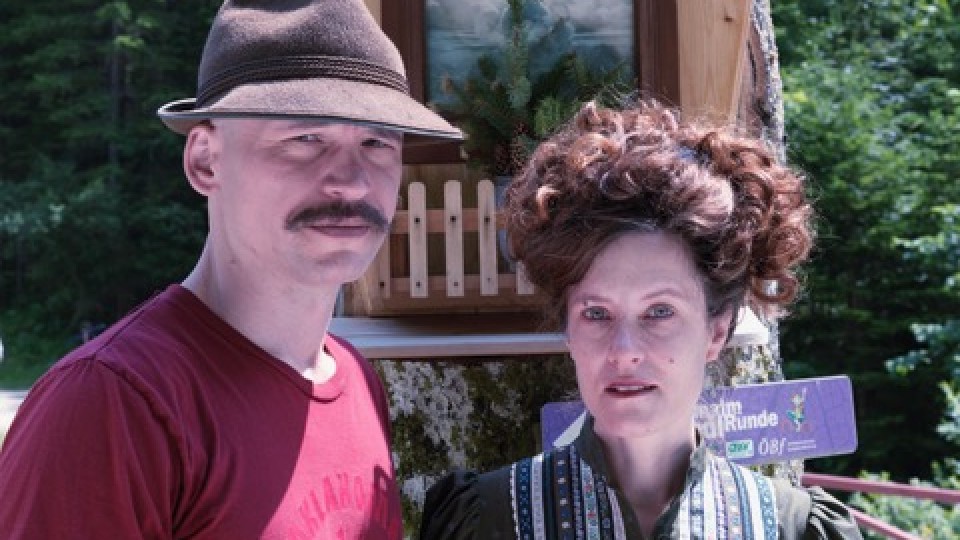2017 was not the first visit Kelly Copper and Pavol Liska from the Nature Theater of Oklahoma had made to the festival steirischer
herbst – but this time, inspired by the genre of the Heimatfilm, equipped with two Super 8 cameras and accompanied by a group
of non-professional actors and volunteer local helpers, they searched the forest and mountain landscape of Upper Styria for
film motifs and vestiges of Elfriede Jelinek. Jelinek’s powerfully eloquent novel provided the literary basis for the film
project DIE KINDER DER TOTEN, where the American performance artists stage a gruesomely eccentric march of the undead in silent
film format.
DIE KINDER DER TOTEN is a very interesting hybrid project in which theatre, performance, literature and film merge into one another. It’s not your
first project that combines performance and filmmaking. What does the medium film add to your work as performance artists?
KELLY COPPER: Film has always been a big inspiration for us, and our connection to it is old and deep. We used to live pretty much next
door to Anthology Film Archives in New York, and saw everything from silent film through the 1960s avant garde works of Jack
Smith, Ken Jacobs, Andy Warhol, Tony Conrad, Jacques Rivette, etc
their work was a continuous reminder that you could have
poor means (broken cameras, stolen film, borrowed costumes, untrained actors
) and still set a high standard for the work
itself. What film allows us in particular as performing artists is a way of capturing and preserving accident, inspiration,
singular poetic gifts of nature, of chance – in theater you always have to be able to repeat. Theater is about trying to keep
everything alive in the moment, but you must repeat it from night to night. Working with film has allowed us to capture once
in a lifetime, one moment in time – those magic inspirational things that usually just happen in rehearsal when you’re working
on a strictly theater piece – when we record them on film or video, we can actually incorporate them precisely into the work
itself, and they become part of the content, which is very important to us.
In case of DIE KINDER DER TOTEN there’s one additional layer – literature – with one of the major yet not very accessible novels by Nobel-prize winner Elfriede
Jelinek. Had you known her novels before? How was your encounter with this text? What was the first impression the Die Kinder der Toten made on you?
KELLY COPPER: Of course we had read Elfriede’s work before, for years, but always in translation. We’re not that sophisticated in our German
language skills. And for this novel there is as yet no English translation available, so it must be said that our access to
it was – special, selective – mainly culled from other people’s accounts of their reading – plus we consulted a partial translation
in progress of the first hundred or so pages that we had. It was an imperfect access we had to the book itself. What was
of primary interest to us was the relationship that that text had to the landscape. We were invited to make a work in the
Styrian countryside. We were looking for some text that had a relationship to the region, and the novel Die Kinder der Toten is specifically, deeply grounded in this particular location. The natural world and the landscape is even, I would say, a
primary player in the novel – having an almost antagonistic relationship to the humans. There are landslides, avalanches
torrential rains. You get that sense of menace, the menace of the natural world – when you walk around the Schneealm, there’s
so much beauty in the landscape, but – there are also everywhere signs of natural disaster and death. Crosses with little
poems about how this or that person was killed in a flash of lightning. You hear about someone going out in the snow and not
returning. We felt immediately that it was the right choice, just due to the intimate relation with place. Heimat. Another
thing we have been interested in for this project is exploring specific film genres. We knew we were interested in the Heimat
film as a genre – and the Jelinek text also suggested the zombie film. So we had two genres to play with. In fact, Jelinek
says that her novel was inspired by an American B horror film, Carnival of Souls by Herk Harvey, which is about this young woman, an organist in a church, who has died but who doesn’t yet realize that she’s
dead. The fact that the novel, too, was inspired by film – also was attractive to us. If we could somehow take this Austrian
high literary novel inspired by American trash horror movie and bring it through our work in the Austrian countryside back
to its origin
that was the perfect invitation and perfect confluence of coincidences, for us.
The Children of the Dead was not your first performance within the festival steirischer herbst. How would you describe the particular challenge of
this project compared to your previous works?
KELLY COPPER: Everything we make is always, in a way, starting from beginning. We work out of our ignorance and incompetence in the given
set of circumstances we have to, by choice, deal with in each new project. We try to do something we don’t know how to do.
So, though there are commonalities: for instance, No Dice, our first piece that was performed at steirischer herbst, was inspired by the films of Jacques Rivette (OUT:1 and Celine and Julie go Boating), so it has certainly a connection to film. Also it had some audience participation – we made sandwiches for the audience,
and we had the performers speak directly to them, but it was a live performance FOR an audience. No matter how we tried to
involve the audience, and implicate them in the performance, they remained basically spectators, and for this project – DIE
KINDER DER TOTEN – we wanted the camera to be the spectator, and for our “audience” to be active participants in the work.
The idea being, that you can’t truly experience a work of art unless you participate in its creation. Of course some people
still watched from the sidelines, but we – our number one goal was really to invite and cajole them into participating in
making the piece, for the so-called audience to be our collaborator. That is probably its biggest difference from the earlier,
more conventional theater work; the fact that the “audience” was engaged in the performance directly.
How did you find access to text so that you could conceive a screenplay? What were the inspiring motifs, characters, atmospheres,
events you picked for you interpretation of the book?
KELLY COPPER: Well, as mentioned earlier – we were limited to just whatever we could glean about the text from talking with people who
had read it. Also we watched Carnival of Souls and Erich von Stroheim’s Blind Husbands, and we visited and got to know, multiple times, in every season of the year, the location in which we would be working.
This project really developed over the course of two years worth of visits to Neuberg, Krampen, Kapellen, visiting specific
locations mentioned in the book, Totes Weib Wasserfall, Mariazell, the Mürz, the Schneealm
during one of our first visits
to Neuberg we were sitting outside a café when they brought the cows down from the summer pasture on the Schneealm. There
were cows and – for some reason – also motorbikes on the road that day, some kind of peculiar confluence of cows and motorcycles.
And we met some men who worked at one of the ski lodges in the mountains. We talked about the landscape, the challenges
we
talked with the owner of the Gasthaus where we were staying, met the man who runs the local grocery store who also is member
of a club for people who collect vintage motorbikes and tractors
we really tried to discover what was special about the region
and its people, and what opportunities there were there for us to play
what are the things which take place in each season,
etc
and we wrote our own screenplay to best make use of all that the town and its inhabitants had to offer. We wrote the
cows into our script, we included the local grocery store
we wrote the food we ate into the script, we wrote the Gasthaus
into the script
some of these things are also in the Jelinek novel, some are in the movie Carnival of Souls
and some are just our pure invention from what the place inspired. And then there is also the flip side – the story of what
we wanted to film from the novel and could not – like Mariazell. No one would let us shoot film anywhere near that church!
But the festival reached out to Stift Rein, another well-known church in the area, and so this is where we set our church
scene. There is also a group of characters from Syria who are in our screenplay but absent from Jelinek’s novel. They, in
part, were introduced because Syria was in the news every day while we were working on this – and my mother (who was going
through treatment for cancer at the time) was constantly confusing “Styria” where we were working with “Syria” – she was concerned
we were going into a war zone. And I think there is, in the end, some connection there with Jelinek’s feeling for history
and the victims of history that haunt a landscape. Buried history. The stuff you don’t want to deal with.
The novel is a massif of a text, that is biting, grotesque and witty, mercilessly going deep into the sore spots of Austrian
society. You have succeeded incredibly well in grasping the balance between the repulsive and the humorous, and also in capturing
with irony what I’d consider as the deeply Austrian. How can one imagine your search for images?
KELLY COPPER: We always spend a lot of time in the place where we work. We get to know, as I said, the landscape and the people. This
for us was also one of the reasons for starting our work with film. When you just come to perform your little show somewhere
– it’s maybe one week, you show up, you do your dance or your theater and you leave. We had been doing this for years and
it felt all very disconnected from place. We were performing mainly in Europe, we were away from our own home, living mainly
like transients, and we had a real desire to find a way to work deeply, locally, and take the time to make something which
would have meaning in the place where it was being made and performed, that our work would somehow be necessary and relevant.
So if we did that – it makes me happy you say such a thing, that it feels deeply Austrian. But sometimes it’s not on an intellectual
level, but intuitive gut level – subterranean – and of course we asked Austrians, too, to bring us their – whatever they had
in their closets that was meaningful to them
we asked to work in places which were local and which had these pictures hanging
on the walls, which had home made needlepoint and which – basically contained their own images. So there is that too. We had
eyes to see what was in front of us every day while shooting, and used it.
The shooting took place in Upper Styria, a region where Elfriede Jelinek spent parts of her childhood and which serves as
the backdrop of the novel. How would you describe the landscape? How did you discover and choose the locations for the shooting?
KELLY COPPER: The landscape was super inspiring. In particular the Schneealm, which I loved so much – it’s just so stark, so vast, so brutal
in its beauty. But also the forests and meadows and the Mürz... We were lucky over the 2 or so years to see the locations
in all the seasons. We were there for the first time just after a snowstorm when everything was covered with white and ice.
Actually, Elfriede Jelinek, for one of our first visits, gave us the key to her childhood home. We hiked up in something
like a half meter of snow to the cabin and looked around – it’s tucked back into the mountain, there are hunters blinds and
trees... it was so special. Later in the year we came back and went hiking up on the Schneealm and saw bighorn sheep – and
the cows grazing in the mountain pasture. We spent an afternoon just sitting with the cows and watching them and listening
to the sounds there. Both Pavol and I found it hugely inspiring. And we had an amazing guide and help in our production manager,
Jakob Schweighofer, who took us literally everywhere, who made friends with the people whose help we needed to make the work
– who made a connection with mountain rescue and the parks people so we could have the permission to film where we needed
he is the unsung hero of this project. He is from steirischer herbst, knows the area well, and operates with such respect both for the artists and for the people who live and work there. It’s
so important to have someone like him.
It’s an amazing idea to conceive the adaptation of a literary work that conveys (among other things) the denial of and the
silence about the Austrian Nazi past as a silent movie. How did this idea come up?
KELLY COPPER: When we were first looking at the region, we were thinking that what we wanted to do was make a kind of “heimatfilm”. This
was a genre we were interested in, which also has this kind of idealized, romanticized version of the rural life – which in
many ways, post-WW2, was also a negation of the war and the unseemly past and atrocities. When we were doing early research,
I remember Claus Philipp, who developed this project with us, showed us archival 8mm and 16mm films from the region, which
of course encompassed some of the time of the war, and you could see the swastikas flying near Mariazell, and soldiers marching,
and it’s very strange to see this same beautiful landscape, smiling people – and these symbols of the Nazis. And you realize,
when you’re watching the films – sometimes a color film – that it’s not so long ago! It’s not ancient history.
And still you had to write dialogues. How difficult was that given the fact that there are no dialogues in the novel?
KELLY COPPER: Well, it was not that difficult. The challenging thing was that, since we were shooting super 8 film on old cameras – we
did not shoot any reference audio. The film is all silent. So we had actors speaking lines in German – and no way to know
what was being said! When you get the footage back, you know what you shot, but it’s all silent and I have to say that –
in the edit – where I was working with all this silent material, reading lips in German – that was one of the most challenging
aspects for me: to put the correct footage with the correct text. We tried our best as we worked to document exactly which
scenes we were shooting, but sometimes we had only a short time – shooting two cameras with cartridges of film that last only
3 minutes before they need reloading. There’s not much time out to precisely mark which pages of text you just shot, so in
the end it was a lot of lip reading
Why did you decide to shoot on Super-8. What did it mean in practical terms to shoot with a Super-8 camera, especially with
regards of the film material?
KELLY COPPER: First and foremost, we’ve always loved Super 8. In fact, I have about 700 reels that I’ve collected over the years of Super
8 and 8mm films, home movies, amateur porn, etc
that, when I first moved to NY, they would sell at flea markets on the street.
You could wander through flea markets and pick up boxes of other people’s home movies. No one wanted them. And we bought
an old projector for nothing and would take these boxes of movies home like they were treasure and spend the nights watching
them, wondering who they were, how their precious personal films ended up in a box in a flea market. I came to the conclusion
that most of the people who shot these films were dead – had died – and no one wanted or knew what to do with these old films.
They were full of ghosts. And so beautiful, most of them. 8mm film is also interesting, because it was the first film format
which was really available to the amateur. It was the people’s format. Cheap, easy to shoot. And for the first time people
could record their daily life – and for the most part they filmed only what was best and beautiful. I have boxes full of Easter
dresses, parades, weddings, Christmas, vacations by the beach, road trips, births, puppies, kittens
so it’s a nostalgic format
in many respects. Similar to the heimatfilm. And a populist format – which is always our aspiration. We don’t come to the
work as experts, though we have been steeped in film history and film love – we are, in the end “amateurs” and you can feel
this love of film and film texture and film history I think in the work. As far as practically – what it meant to shoot in
Super 8: we were working with two refurbished antique cameras. We tested them extensively before we left New York, and one
of them was having a problem with the lens
we thought we got it fixed, but, these things are never perfect. It’s always whatever
it is
they are not perfect machines. So one of the cameras in low light always had a kind of soft focus that we had to work
with and embrace. In addition, we had to shoot without any audio in camera. There is no reference audio, we just have hours
of silent film in the end, and we have to build the soundscape from the bottom up in post-production. To that end, we were
able to have an audio person working with us for some days, and he would go with a recorder and microphone and capture all
the ”local” sounds which we wanted – like the cows and the Schneealm and the trees. I’m very grateful for that.
The adaptation required a considerable number of participants and actors. You principally work with non-professional actors,
how did you find them? Did you take part in the casting process? Given the circumstances – little time, little money, limited
film material – how do you prepare your actors for the shoot to get them so quickly to the point?
KELLY COPPER: We went actually a year earlier in the autumn to meet people that steirischer herbst had found for us in the region (also in Graz and in Vienna, a few people
) who wanted to be involved on camera. We knew
we were looking for about 20 principals, and we had a chance to meet them and – mainly to know what they wanted from the experience,
and to let them know that it would be a great deal of work, probably some of it outside, in rain, in cold
that the hours
could be long. It was important to us that they understood it was not a “professional” film world we were working in
there
would be no catering, no trailers
if someone needs help holding a light or putting on makeup, we don’t want anyone involved
who would say “that’s not my job.” It’s always communal work. It’s a utopia that we make for a period of a few weeks where
everyone is a team building this thing together. We asked the potential participants if they had any problem with doing different
things that they might be asked to do. They had no idea what we were making, so – I think back to poor Greta Kostka, who played
Karin Frenzel’s mother in the film, a nice woman in her 60s, and we are asking her at first meeting: “are you okay wrestling
another woman? Is it okay if you have to slap each other in the face with fish?” She must have thought we were mad. But you
quickly discern who really wants this and who needs it. Pavol and I try to make only work that we need to do, and because
we need to do it – we will do everything to make it happen. And that’s what we need above all in the cast. That spirit of
everyone helping push the boulder up the hill. And we found that. The people we had for the main cast were without exception
all wonderful, generous – and they stay connected by this experience, to us and to each other. We originally had a team of
4-5 makeup people from a university I think. Those people were the only ones we didn’t talk to, and they got in on the first
day, and it wasn’t professional enough for them and they decided to back out. It says a lot about everyone who was left that
that night the team was watching youtube videos on how to do makeup, how to make someone look dead, etc
We needed brains,
and we took jello dessert that was from that evening’s dinner and put it aside. The movie is a result of a group of people
working creatively together to solve problems. And the aesthetics is the result of doing the necessary work.
We can’t hear people’s voices, when they are supposed to communicate. Even more important and multilayered is therefore the
sound design with noises, music and language. How was your collaboration with Wolfgang Mitterer? What did this soundscape
add to make your film a whole?
KELLY COPPER: Well, it’s actually a collaboration with more than just Wolfgang
It’s also work we did with our sound designer Matz Müller
and Tobi, and the team at Sonnenstudio. We spent a week working with them on the audio. We had some meetings with Wolfgang,
as well, of course, as he was composing the score, but then it all really came together that week working on audio in Berlin.
We spoke to Matz about using foley sound and really building the audio up from scratch, knowing that anything was possible
– but not everything should be done. Matz, for his part, didn’t want to be too on the nose with the sounds, so there’s some
interesting slide between what you see and what you hear. And then the music really added another layer (and also, Wolfgang’s
music comes with it’s own kind of found sound, its own aesthetic) – so putting the pieces together and deciding which is on
top at which time and when to pull back – what to subtract at certain moments – really made magic, I think. Matz and Wolfgang
have worked together before, so they gave each other total permission and freedom, as well. Everyone just wanted to do the
best work. We have never had a week in a good sound studio to play like that and stretch ourselves – and these guys really
do know what they are doing, so that was brilliant.
The film opens with the noises and the picture of an analog film projection, and it closes in the same manner. You are taking
us, the viewers, into a film within a film
What were your thoughts behind this narrative framework?
KELLY COPPER: In our version of Die Kinder der Toten, film is a kind of character as well as the medium through which the dead come back to life. This is not in Jelinek’s novel,
but it is in our version. So film is a medium of transmission – not only of story, but of spirit. It’s a direct link to the
ghost world. To the past. And so the projector at the beginning is a kind of way of foregrounding that idea, and film as not
just a media, but a medium. Even if you look at the word for film screening or projection in French – it’s “séance” – exactly
the same word used for conjuring up the dead, which is what it must have seemed like to people when they first beheld moving
images made of light. It’s magic.
Interview: Karin Schiefer
January 2019

